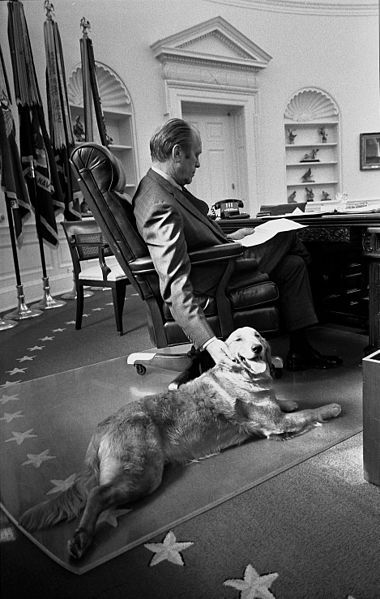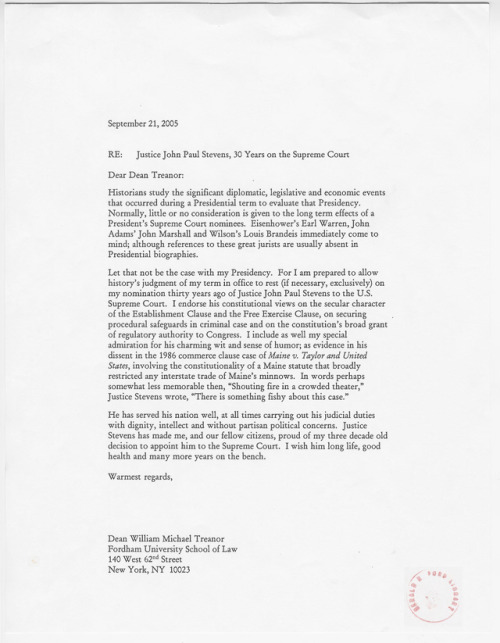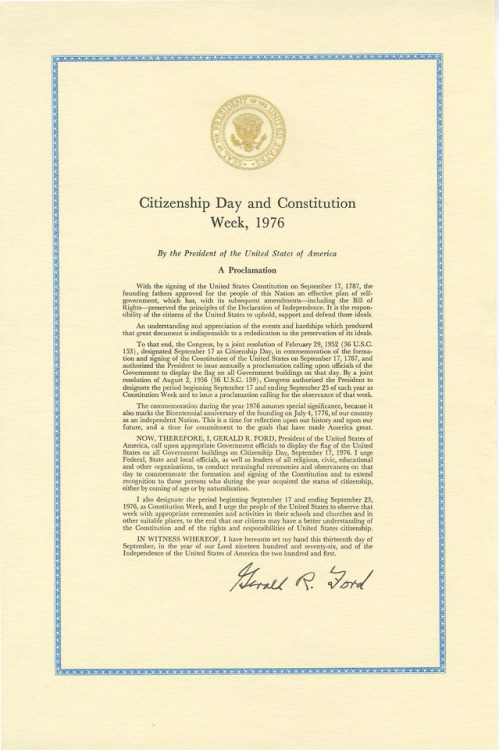#president ford

In the South China Sea, crewmen of the amphibious cargo ship USS Durham take Vietnamese refugees aboard a small craft, 4/3/1975. NARA ID 558518.
OTD 1975: Operation “Baby Lift” ends
More than 3,300 Vietnamese orphans rescued

Vietnamese Refugee Children on an Operation Babylift Flight Arriving at San Francisco International Airport, 4/5/1975. Ford Library, NARA ID 12007111.
In April 1975, the North Vietnamese captured Saigon, taking control of South Vietnam and marking the end of the Vietnam War. In the chaotic final days before the fall of Saigon, President Gerald Ford ordered the evacuation of Vietnamese orphans.
The mission, officially named Operation Babylift, began April 3, 1975 and ended #OTD 1975, only 16 days before the fall of Saigon and the end of the war. In all, more than 3,300 children were evacuated to the United States.
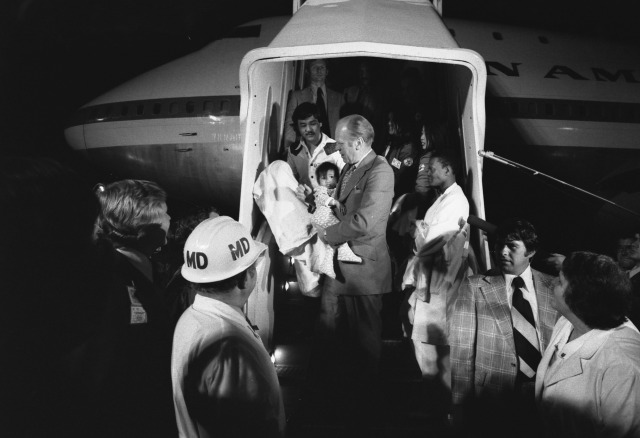

President Gerald R. Ford greets and holds Vietnamese refugee babies at San Francisco International Airport Following the Arrival of an Operation Babylift Plane from South Vietnam" 4/5/1975. NARA IDs 7839930and23869153.

Shoes from a Child Transported During Operation Babylift, 1975. Ford Library.
See the National Archives’ Remembering Vietnam online exhibit. Special exhibit tour with curator Alice Kamps below:

Today is Flag Day!
Here Congressman Jerry Ford unfurls a replica of the flag that flew over Fort McHenry in Baltimore, Maryland, providing the inspiration for Francis Scott Key to write “The Star Spangled Banner.“ It was one of the notable flags in our nation’s past that he highlighted while discussing the history of Flag Day in this 1955 film for his constituents in Michigan’s Fifth District.
Celebrated annually on June 14, Flag Day commemorates the adoption of the flag of the United States by the Second Continental Congress on that day in 1777.
Source - YouTube

Now available in the CIA’s Freedom of Information Act Electronic Reading Room: “Nixon and the People’s Republic of China: CIA’s Support of the Historic 1972 Presidential Trip”
Recently released, this collection marks the 50th anniversary of President Richard M. Nixon’s February 1972 trip to the People’s Republic of China (PRC) – a landmark event that preceded the establishment of diplomatic relations between the two countries. It includes a subset of the materials CIA produced for President Nixon and National Security Advisor Henry Kissinger in preparation for the seven-day visit. This trip paved the way for Gerald R. Ford’s visits to the PRC in June 1972 and December 1975.
Learn more and access the materials online here: https://www.cia.gov/readingroom/collection/nixon-collection
Image: President Ford and daughter Susan watch as Secretary of State Henry Kissinger shakes hands with Mao Tse-Tung; Chairman of Chinese Communist Party, during a visit to the Chairman’s residence, 12/2/1975 (National Archives Identifier 7062596, https://catalog.archives.gov/id/7062596)
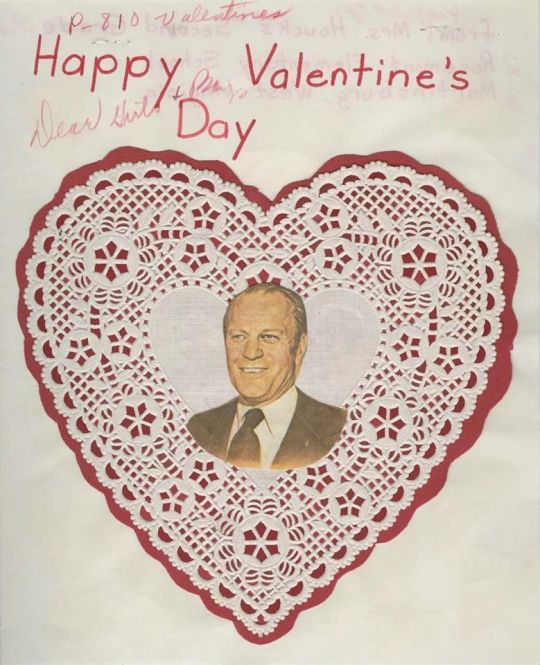
Happy Valentine’s Day!
Mrs. Houck’s second grade class from Rosemont Elementary School in Martinsburg, West Virginia, showed their love for President Ford with this valentine in 1975.
Pearl Harbor Remembrance Day
President Ford attended a memorial ceremony held at the USS Arizona Memorial at Pearl Harbor on December 7, 1975. Although he was the third President to visit the Memorial, he was the first to do so on the anniversary of the attack.
The ceremony included the presentation of floral wreaths by 37 veterans and civic organizations. Before placing his own wreath President Ford delivered remarks about the significance of December 7, 1941, and the memorial:
We who remember Pearl Harbor will always remember. For us it is a moment etched in time, a moment of shock and mixed feelings and particularly disbelief, a moment of shame and a moment of sorrow, of anguish and of anger, an end to irresolutions, a summons to action, the start of a total commitment that comes but rarely to men and to nations.
Whoever watched the Pacific churned by winds of wars comes to this hallowed place with feelings overcoming words. Our shipmates who rest in honor here, our comrades in arms who sleep beneath the waves and on the islands that surround us need no eulogy beyond the eternal gratitude of the land that they loved.
Post link
Sweater weather is here! President Ford sported this hand-knitted “WIN” patterned pullover supporting the Whip Inflation Now campaign during his family’s holiday vacation in Vail, Colorado. December 25, 1974.
Source:fordlibrarymuseum.gov
Post link

Track and field star Jesse Owens received the Presidential Medal of Freedom 45 years ago this week on August 5, 1976. President Ford presented him with the nation’s highest civilian honor 40 years after his record setting performance at the 1936 Summer Olympics.
Held in Berlin, Adolf Hitler intended to use the 1936 Games to promote the Nazi regime and its ideas of Aryan superiority. The U.S. Men’s Track and Field team proved him wrong with five Black athletes earning eight gold medals. Jesse Owens won four of them, making him the most successful athlete at those Olympics. He came in first individually in the 100 meters sprint, 200 meters sprint, and long jump before anchoring the 4x100 meters relay team that set a new world record.
“Giants like Jesse Owens show us why politics will never defeat the Olympic spirit,” President Ford said when presenting the Medal of Freedom. “His character, his achievements have continued to inspire Americans as they did the whole world in 1936.”
The full citation read: “To Jesse Owens, athlete, humanitarian, speaker, author – a master of the spirit as well as the mechanics of sport. He is a winner who knows that winning is not everything. He has shared with others his courage, his dedication to the highest ideals of sportsmanship. His achievements have shown us all the promise of America and his faith in America has inspired countless others to do their best for themselves and for their country.”
Image: President Gerald Ford and Jesse Owens during the Presentation of the Presidential Medal of Freedom in the East Garden of the White House, 8/5/1976 (B0973-14 / National Archives Identifier 7062576)
Remembering John Paul Stevens, 1920-2019
We are sad to mark the passing of Supreme Court Justice John Paul Stevens earlier this week at age 99. He was the third longest serving justice at the time of his retirement in June 2010, just under 35 years after President Ford appointed him to the Supreme Court.
Born in Chicago, Stevens graduated from the University of Chicago in 1941. He served in the Navy during World War II as an intelligence officer in the Pacific Theater. After the war he attended Northwestern University School of Law and graduated first in his class. Stevens then served as a law clerk to Supreme Court Justice Wiley Rutledge before entering private practice. He worked for law firms in the Chicago area, including one he helped form, for many years, dealing mostly with litigation and antitrust law. Additionally, he taught law classes part time and gained experience serving as counsel on Federal committees.
Stevens became a United States Circuit Judge for the Seventh Circuit Court of Appeals in October 1970. He served in that capacity until November 1975 when President Ford nominated him to fill the Supreme Court vacancy created by the retirement of Justice William O. Douglass. “Judge Stevens is held in the highest esteem by his colleagues in the legal profession and the Judiciary and has had an outstanding career in the practice and the teaching of law as well as on the Federal Bench,” President Ford said in his nomination remarks. “I am confident that he will bring both professional and personal qualities of the highest order to the Supreme Court.”
The Senate quickly confirmed Stevens with a vote of 98-0 and he took his seat on the bench on December 19, 1975. Although he was registered as a Republican when he was appointed, over time he became viewed as part of the liberal wing of the Supreme Court. President Ford never regretted nominating Stevens. “He has served his nation well, at all times carrying out his judicial duties with dignity, intellect, and without partisan political concerns. Justice Stevens has made me, and our fellow citizens, proud of my three decade old decision to appoint him to the Supreme Court,” President Ford wrote in a letter honoring Justice Stevens in 2005. Stevens received a copy of the letter, which he reportedly displayed in his Supreme Court chambers.
Images: President Gerald Ford, Chief Justice Warren Burger, and John Paul Stevens at the U.S. Supreme Court Building for the Swearing-in of Stevens as an Associate Justice, 12/19/1975 (National Archives Identifier 6926435)
Letter from President Gerald R. Ford to Dean William Michael Treanor regarding Justice John Paul Stevens, 30 Years on the Supreme Court, 9/21/2005, from the Ford Post Presidential Office Files, Box A544, folder “Correspondence File, 2005 [To-Tu]”
Letter from Justice John Paul Stevens to President Gerald R. Ford, 10/11/2005, from the Gerald and Betty Ford Special Materials, Box A10, folder “Stevens, John Paul”
Post link
With the signing of the United States Constitution on September 17, 1787, the founding fathers approved for the people of this Nation an effective plan of self-government, which has, with its subsequent amendments – including the Bill of Rights – preserved the principles of the Declaration of Independence. It is the responsibility of the citizens of the United States to uphold, support and defend those ideals.
–President Ford’s Proclamation for Citizenship Day and Constitution Week, 1976
Constitution Day and Citizenship Day commemorates the signing of the Constitution, and encourages people to learn more about their rights and responsibilities as citizens of the United States.
The Constitution is on permanent display year round at the U.S. National Archives in Washington, DC. Read the full transcription of it on the National Archives website. Explore additional resources for learning and teaching about the Constitution from the National Archives Education Updates blog.
Image:President Ford’s Citizenship Day and Constitution Week, 1976, Proclamation
Post link



